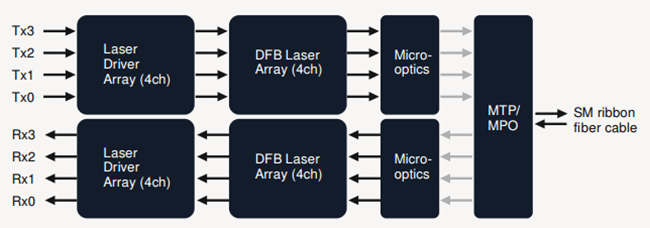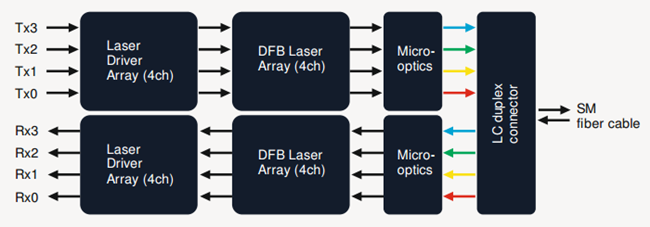It is well known that 40GBASE-SR4 QSFP+ transceiver
uses a parallel multimode fiber (MMF) link to achieve 40G. It offers
four independent transmit and receive channels and each channel is
capable of 10G operation for an aggregate data rate of 40G with
distances up to 100 meters on OM3 MMF or 150 meters on OM4 MMF. However,
for 40GBASE-LR4 QSFP+ transceivers, two kinds of links are available.
One is parallel single-mode fiber (PSM), and the other is coarse
wavelength division multiplexing (CWDM). What is the difference between
the two? Keep reading this article and you will find the answer.
40GBASE-LR4 PSM QSFP+ Transceiver
PSM
QSFP+ transceiver is a parallel single-mode optical transceiver with an
MTP/MPO fiber ribbon connector. Moreover, it offers four independent
transmit and receive channels and each channel is capable of 10G
operation for an aggregate data rate of 40G on 10 km of single-mode
fiber. The guide pins inside the receptacle could ensure proper
alignment. Usually, the cable cannot be twisted for proper channel to
channel alignment. For a PSM QSFP+ transceiver, the transmitter module
accepts electrical input signals compatible with common mode logic (CML)
levels. All input data signals are differential and internally
terminated. The receiver module converts parallel optical input signals
via a photo detector array into parallel electrical output signals. The
receiver module outputs electrical signals are also voltage compatible
with CML levels. All data signals are differential and support a data
rates up to 10.3G per channel.

40GBASE-LR4 CWDM QSFP+ Transceiver
The 40GBASE-LR4 CWDM QSFP+ transceiver like QSFP-40GE-LR4
is compliant to 40GBASE-LR4 of the IEEE P802.3ba standard. It has a
duplex LC connector for the optical interface and its maximum
transmission distance is 10 kilometers. Single-mode fiber (SMF) has to
be used to minimize the optical dispersion in the long-haul system. This
transceiver converts 4 inputs channels of 10G electrical data to 4 CWDM
optical signals by a driven 4-wavelength distributed feedback (DFB)
laser array, and then multiplexes them into a single channel for 40G
optical transmission, propagating out of the transmitter module from the
SMF. Reversely, the receiver module accepts the 40G CWDM optical
signals input, and demultiplexes it into four individual 10G channels
with different wavelengths. The central wavelengths of the four CWDM
channels are 1271, 1291, 1311 and 1331 nm as members of the CWDM
wavelength grid defined in ITU-T G694.2. Moreover, each wavelength
channel is collected by a discrete photo diode and output as electric
data after being amplified by a transimpedance amplifier (TIA).

Differences Between the Two
From
the perspective of an optical transceiver module structure, PSM seems
more cost effective as it uses a single uncooled CW laser splitting its
output power into four integrated silicon modulators. Moreover, its
array-fiber coupling to an MTP connector is relatively simple. However,
from the perspective of an infrastructure, PSM would be more expensive
when the link distance is long, because it uses 8 optical single-mode
fibers while CWDM only uses 2 optical single-mode fibers. The following
table illustrates the main differences between CWDM and PSM.

In
addition, the caveat is that the entire optical fiber infrastructure
within a data center, including patch panels, has to be changed to
accommodate MTP connectors and ribbon cables, which are more expensive
than conventional LC connectors and regular SMF cables. Moreover, it is
not a straightforward tack to clean MTP connectors. So CWDM is a more
profitable and popular 40G QSFP link.
Summary
For
40GBASE-LR4 QSFP+ transceivers, either CWDM link or PSM link, the
maximum transmission distance is both 10 km. 40GBASE-LR4 PSM QSFP+
transceiver uses an MTP/MPO fiber ribbon connector via 8 optical
single-mode fibers to reach 40G, while 40GBASE-LR4 CWDM QSFP+
transceiver uses a duplex LC connector via 2 optical single-mode fibers
to achieve 40G. Thus, CWDM QSFP+ enables data center operators to
upgrade to 40G connectivity without making any changes to the previous
10G fiber cable plant, which is more cost-effective and widely used by
people.
没有评论:
发表评论